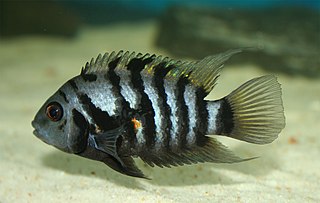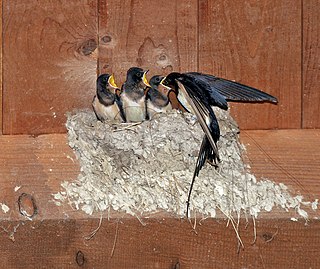
Horse breeding is reproduction in horses, and particularly the human-directed process of selective breeding of animals, particularly purebred horses of a given breed. Planned matings can be used to produce specifically desired characteristics in domesticated horses. Furthermore, modern breeding management and technologies can increase the rate of conception, a healthy pregnancy, and successful foaling.

Birth is the act or process of bearing or bringing forth offspring, also referred to in technical contexts as parturition. In mammals, the process is initiated by hormones which cause the muscular walls of the uterus to contract, expelling the fetus at a developmental stage when it is ready to feed and breathe.

Weaning is the process of gradually introducing an infant human or another mammal to what will be its adult diet while withdrawing the supply of its mother's milk.

Helpers at the nest is a term used in behavioural ecology and evolutionary biology to describe a social structure in which juveniles and sexually mature adolescents of either one or both sexes remain in association with their parents and help them raise subsequent broods or litters, instead of dispersing and beginning to reproduce themselves. This phenomenon was first studied in birds where it occurs most frequently, but it is also known in animals from many different groups including mammals and insects. It is a simple form of co-operative breeding. The effects of helpers usually amount to a net benefit, however, benefits are not uniformly distributed by all helpers nor across all species that exhibit this behaviour. There are multiple proposed explanations for the behaviour, but its variability and broad taxonomic occurrences result in simultaneously plausible theories.

The Cape fox, also called the asse, cama fox or the silver-backed fox, is a small fox, native to southern Africa. It is also called a South African version of a fennec fox due to their big ears.

The pygmy marmoset, genus Cebuella, is a small genus of New World monkey native to rainforests of the western Amazon Basin in South America. It is notable for being the smallest monkey and one of the smallest primates in the world, at just over 100 grams (3.5 oz). It is generally found in evergreen and river-edge forests and is a gum-feeding specialist, or a gummivore.

Alloparenting is a term used to classify any form of parental care provided by an individual towards a non-descendant young. Non-descendant refers to any young who is not the direct genetic offspring of the individual, but does not exclude related young such as siblings or grandchildren. Individuals providing this care are referred to using the neutral term of alloparent.

Pack is a social group of conspecific canines. Not all species of canids form packs; for example, small canids like the red fox do not. Pack size and social behaviour within packs varies across species.

The convict cichlid is a fish species from the family Cichlidae, native to Central America, also known as the zebra cichlid. Convict cichlids are popular aquarium fish and have also been the subject of numerous studies on fish behaviour.
Life history theory is an analytical framework designed to study the diversity of life history strategies used by different organisms throughout the world, as well as the causes and results of the variation in their life cycles. It is a theory of biological evolution that seeks to explain aspects of organisms' anatomy and behavior by reference to the way that their life histories—including their reproductive development and behaviors, post-reproductive behaviors, and lifespan —have been shaped by natural selection. A life history strategy is the "age- and stage-specific patterns" and timing of events that make up an organism's life, such as birth, weaning, maturation, death, etc. These events, notably juvenile development, age of sexual maturity, first reproduction, number of offspring and level of parental investment, senescence and death, depend on the physical and ecological environment of the organism.
Cross-fostering is a technique used in animal husbandry, animal science, genetic and nature versus nurture studies, and conservation, whereby offspring are removed from their biological parents at birth and raised by surrogates. This can also occasionally occur in nature.
Monogamous pairing in animals refers to the natural history of mating systems in which species pair bond to raise offspring. This is associated, usually implicitly, with sexual monogamy.
Canine reproduction is the process of sexual reproduction in domestic dogs, wolves, coyotes and other canine species.
Cooperative breeding is a social system characterized by alloparental care: offspring receive care not only from their parents, but also from additional group members, often called helpers. Cooperative breeding encompasses a wide variety of group structures, from a breeding pair with helpers that are offspring from a previous season, to groups with multiple breeding males and females (polygynandry) and helpers that are the adult offspring of some but not all of the breeders in the group, to groups in which helpers sometimes achieve co-breeding status by producing their own offspring as part of the group's brood. Cooperative breeding occurs across taxonomic groups including birds, mammals, fish, and insects.

The paucident planigale, also known as Giles' planigale, is a very small species of carnivorous marsupial of the family Dasyuridae.

In animals, infanticide involves the killing of young offspring by a mature animal of the same species, and is studied in zoology, specifically in the field of ethology. Ovicide is the analogous destruction of eggs. The practice has been observed in many species throughout the animal kingdom, especially primates but including microscopic rotifers, insects, fish, amphibians, birds and mammals. Infanticide can be practiced by both males and females.

Parental care is a behavioural and evolutionary strategy adopted by some animals, involving a parental investment being made to the evolutionary fitness of offspring. Patterns of parental care are widespread and highly diverse across the animal kingdom. There is great variation in different animal groups in terms of how parents care for offspring, and the amount of resources invested by parents. For example, there may be considerable variation in the amount of care invested by each sex, where females may invest more in some species, males invest more in others, or investment may be shared equally. Numerous hypotheses have been proposed to describe this variation and patterns in parental care that exist between the sexes, as well as among species.

Eusociality evolved repeatedly in different orders of animals, particularly the Hymenoptera. This 'true sociality' in animals, in which sterile individuals work to further the reproductive success of others, is found in termites, ambrosia beetles, gall-dwelling aphids, thrips, marine sponge-dwelling shrimp, naked mole-rats, and the insect order Hymenoptera. The fact that eusociality has evolved so often in the Hymenoptera, but remains rare throughout the rest of the animal kingdom, has made its evolution a topic of debate among evolutionary biologists. Eusocial organisms at first appear to behave in stark contrast with simple interpretations of Darwinian evolution: passing on one's genes to the next generation, or fitness, is a central idea in evolutionary biology.
Monogamous pairing refers to a general relationship between an adult male and an adult female for the purpose of sexual reproduction. It is particularly common in birds, but there are examples of this occurrence in reptiles, invertebrates, fish, amphibians, and mammals.
Animals, including siblings, compete for resources such as food, territory, and potential mating partners. In animal sibling rivalry, individuals compete for parental care or limited resources, which can sometimes result in siblicide. Sibling rivalry occurs in many different forms. Siblings may compete for resources in a prenatal and/or post-birth environment. The degree of rivalry varies, ranging from a low level of violence in non-aggressive to the killing of kin in siblicide.













